On the Edge of Extinction

Photo: Jeffery Salter
When Lisa Ling met Kanzi, a bonobo who can communicate with humans, she discovered that it's not only incredible language skills that make Kanzi so rare—bonobos are on the brink of extinction. Primatologist Dr. Mireya Mayor explains what you can do to help with conservation efforts.
Lynn Okura: The bonobo is a highly endangered species. Can you speak to this and the ape conservation efforts our viewers should know about? Dr. Mireya Mayor: Bonobos, arguably our closest relatives, are a species on the edge of extinction. They are found in the Congo Basin rainforests of the central Democratic Republic of Congo (DRC). There are no reliable estimates, but it's thought that as few as 10,000 bonobos are left in the wild today. Compared to what we know about chimps, we know hardly anything about these amazing animals. However, the fact that bonobos share 98.4 percent of their genetic makeup with humans, coupled with their relative rarity and their self-awareness, compel a moral and scientific urgency to preserve them and protect them.
Bonobos are under threat from bushmeat hunters and habitat loss. As a result, their populations have rapidly declined over the last 30 years. Salonga National Park protects 36,000 square kilometers of forest within the heart of bonobo territory, but it is the only national park harboring the species. This park has been invaded by heavily armed gangs of poachers and conservation efforts have been hampered by the civil unrest prevailing in the region. Though there are currently many organizations striving to help these endangered animals, the bonobo's habitat is shared with people. Ultimately, the success of conservation efforts will rely on local and community involvement.
LO: What puts these amazing animals at risk? What can people do to help protect them?
Dr. Mireya Mayor: Bonobos are an endangered species due to several interlocking factors: habitat loss (logging and deforestation), pet trade, civil unrest, increasing poverty and hunting for bushmeat. The latter activity has increased dramatically during the current civil war due to the presence of heavily armed militias even in remote "protected" areas.
Cultural beliefs are also impacting their already difficult plight. Bonobos are occasionally hunted for traditional medicinal or magical purposes because specific body parts are thought to enhance strength and sexual vigor. These magical charms are widely available in some parts of DRC, suggesting that large numbers of bonobos may be killed annually. The coupling of the bonobo's low, fragmented population with their slow reproductive rate means that they are extremely vulnerable to this increase in habitat loss and hunting.
We humans have a responsibility to do everything we can to protect these close relatives or we could soon lose the primate species that shares the greatest genetic connection to humans. From a scientific standpoint, bonobos offer an insightful window into further understanding our own behavior. From an emotion standpoint, what would it say about humanity if we let our closest living relatives disappear?
There are conservationists like me trying to help bonobos, but we can't do it alone. There are things that everyone can do in their lives, at home and at work. It is as simple as being informed about the items you buy, such as what species of wood your dining room table is and where it comes from, or ceasing to use certain brands of cosmetics, hair and soap products that contain palm oil. Palm oil production has been documented as a cause of substantial, and often irreversible, damage to the natural environment. This includes deforestation, habitat loss of critically endangered species, such as the orangutan, and a significant increase in greenhouse gas emissions. It may not seem like much, but these actions add up and are key contributors to the critical issues we now face, thus also part of the solution. The most important thing you can do is to get involved and help spread the word by educating people about the bonobo's plight.
How Dr. Mireya Mayor helped discover the world's smallest primate



